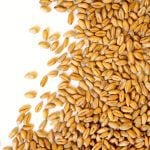Compared to last week, western Canadian yearling prices were steady to $2 lower; calves weighing 500 to 650 lbs. traded $2-$4 lower while lighter weights under 500 lbs. were steady to $5 higher. There is a distinct price structure for each weight category, depending on the time frame for the finished animal.
The overall feeder complex was softer last week as feed barley prices jumped another $5-$10 per tonne; imported corn values were also up $3-$6 per tonne in the Lethbridge area. Finishing feedlots continue to be aggressive for quality yearling packages fresh off grass; however, backgrounded yearlings traded $3-$5 below week-ago levels. Discounts for fleshier yearlings were more severe this past week. Buyers appeared to incorporate a risk discount in some cases due to rising COVID-19 cases and the looming U.S. election. Friday’s Cattle on Feed report from the U.S. Department of Agriculture was expected to be somewhat bearish for the deferred live cattle futures, which also contributed to the softer tone. Auction barns in the eastern Prairie regions had larger volumes last week with many locations holding their first major sale of the season. While Alberta feedlots focused on local cattle, the additional competition took the steam off the market.
Read Also

New opportunities for Canadian goods in Mexico
Agriculture minister’s trip to Mexico sees promotion of Canadian goods like beef and canola, with potential for more partnerships in the future
In the Lethbridge area, red white-face steers just off grass weighing 885 lbs. dropped the gavel at $199. South of Edmonton, mixed steers averaging 890 lbs. were valued at $188 and tan heifers averaging 875 lbs. were quoted at $176. In northwestern Manitoba, a group of medium- to larger-frame Simmental-blended steers weighing just over 900 lbs. were quoted at $183 and black heifers averaging 890 lbs. were reported at $170.
Calf prices were quite variable across the Prairies. Feedlots were more aggressive for the 700- to 800-lb. feeder that was on light forage diet; however, buyers shied away from bawlers under 700 lbs. In central Alberta, tan mixed steers on light silage diet weighing 790 lbs. were quoted at $194 while red mixed heifers weighing 720 lbs. were valued at $188. In Manitoba, tan steers averaging 525 lbs. were reported at $222 and Charolais-blended heifers averaging 530 lbs. sold for $188. South of Calgary, Angus-based steers weighing 610 lbs. were quoted at $225 and black mixed heifers averaging 600 lbs. were reported at $184.
The market has a fair amount of uncertainty in the short term. Rising COVID cases, a looming U.S. election and currency volatility are a few factors in the minds of cattle feeders. USDA’s report showed a year-over-year increase in cattle-on-feed inventories and we still have a large supply of fed cattle backed up on Alberta and U.S. feedlots. Therefore, it’s hard to be bullish on the feeder market in the current environment.
— Jerry Klassen manages the Canadian office of Swiss-based grain trader GAP SA Grains and Produits Ltd. and is president and founder of Resilient Capital, specializing in proprietary commodity futures trading and market analysis. Jerry consults with feedlots on risk management and writes a weekly cattle market commentary. He can be reached at 204-504-8339 or via his website at ResilCapital.com.

















